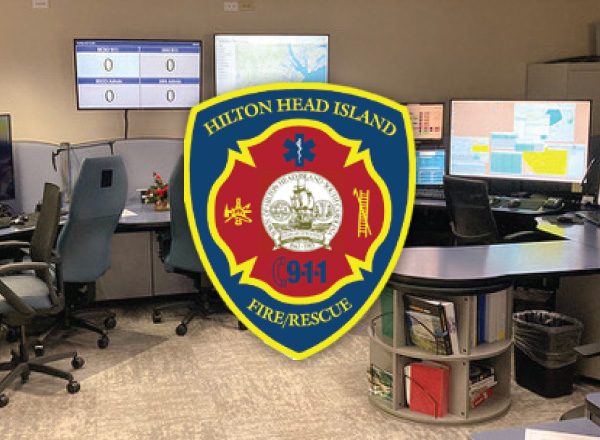About Hilton Head Island Fire Rescue Communications
 The Hilton Head Island Fire Rescue E911 Communications Center serves as the primary emergency communications center for the Town of Hilton Head Island, South Carolina. The center employs 12 emergency telecommunicators across four shifts.
The Hilton Head Island Fire Rescue E911 Communications Center serves as the primary emergency communications center for the Town of Hilton Head Island, South Carolina. The center employs 12 emergency telecommunicators across four shifts.
Hilton Head Island Population (2020 census):
37,661
* population can exceed 150,000 during peak summer months
Annual 9-1-1 calls
(2020):
74,000
Annual Non-Traumatic
Cardiac Arrests
50
CHALLENGE
![]() The Town of Hilton Head Island might be known as a popular summer vacation spot, but is also celebrated for its high-quality emergency medical services. Even so, Hilton Head Island Fire Rescue recognized it could still do more to improve cardiac arrest victims’ chances of survival.
The Town of Hilton Head Island might be known as a popular summer vacation spot, but is also celebrated for its high-quality emergency medical services. Even so, Hilton Head Island Fire Rescue recognized it could still do more to improve cardiac arrest victims’ chances of survival.
So Hilton Head Island Fire Rescue partnered with the expert team at RQI Partners to conduct a Cardiac Arrest System Assessment. Through a series of interviews, and a review of performance metrics and other aspects of the system, the assessment identified focusing on telecommunicator CPR as one of the most effective and efficient ways to improve outcomes. The emergency telecommunicator’s ability to quickly recognize a cardiac arrest and instruct the caller to begin CPR would give the department’s paramedics and EMTs a much greater chance of resuscitating the patient once they arrived on scene.
“We’ve worked hard over the past decade to bring our cardiac arrest survival rate to 50 percent,” says the department’s chief, Brad Tadlock. “Although this is one of the highest survival rates in the nation, we won’t stop there. We know even more people can be saved.”
In the communications center, they found they were not meeting all of their goals on key cardiac arrest performance indicators. It was taking their telecommunicators about 100 seconds to identify a cardiac arrest—within range of the recommended 90 seconds, but not as fast as a department with such high standards hoped to achieve.
Finding time for more frequent training, however, seemed out of reach for a small agency, where sometimes as few as two telecommunicators are on duty at a time.
SOLUTION
![]() In 2020, just weeks before the COVID-19 pandemic began to shut down most of the country, the department implemented RQI-Telecommunicator (RQI-T) to enhance its training and quality improvement program. Some members of the team were unsure about its purpose at first, according to Becky Neugent, the 911 communications manager for Hilton Head Island Fire Rescue.
In 2020, just weeks before the COVID-19 pandemic began to shut down most of the country, the department implemented RQI-Telecommunicator (RQI-T) to enhance its training and quality improvement program. Some members of the team were unsure about its purpose at first, according to Becky Neugent, the 911 communications manager for Hilton Head Island Fire Rescue.
“They were a little bit leery about it,” Neugent says, “just because they were not familiar with it. They all do such an amazing job in the first place, and they may have taken it to mean we thought they were not doing a good job. It really wasn’t about that, it was just about improving the recognition and response to those kinds of events.”

“Our telecommunicators are glad we have RQI T-CPR now. It has really helped them start to recognize some of these traps they could get caught in. If you ask them, they will definitely say they have improved.”
— Becky Neugent, 911 communications manager for Hilton Head Island Fire Rescue
RQI-T provides quarterly training to the department’s telecommunicators, through a combination of a short, self-directed online module and a real-time simulation with an RQI T-CPR specialist. That first spring, the training focused on quickly identifying cardiac arrest without “over-verifying”—or spending too much time trying to confirm the cardiac arrest, resulting in seconds, even minutes, wasted without any CPR. Other quarterly modules cover topics such as instructing callers to move patients or differentiating between cardiac arrest and seizures.
With RQI-T, Neugent and her team also get the program’s quality improvement and analytics. That means Hilton Head Island 911 telecommunicators aren’t only training and practicing on a frequent basis—they also know how effective that training is, and what areas they and their RQI-T coaches should focus on next.
RESULTS
![]() After six months, Hilton Head Island Fire Rescue saw improvement across several critical performance measures. They identified cardiac arrests in under a minute—and had callers performing their first chest compression within
After six months, Hilton Head Island Fire Rescue saw improvement across several critical performance measures. They identified cardiac arrests in under a minute—and had callers performing their first chest compression within
2 minutes and 20 seconds of answering the call, nearly two minutes faster than prior to implementing RQI T-CPR. Research suggests that each minute without CPR decreases a victim’s chance of survival, meaning cardiac arrest victims on Hilton Head Island have a significantly greater chance of returning home to their families.
Neugent and her team have seen firsthand the importance of the quarterly education RQI T-CPR provides. Early on, Hilton Head Island 911 telecommunicators went through training and simulations focused on quickly identifying cardiac arrests, and they immediately saw improvements. But later in the year, the numbers started to slip a little bit.
“We kind of got back into over-verifying,” Neugent says, noting that the addition of COVID-19 screening questions to the protocols may have also contributed to the slight increase in the time it took to identify an arrest. But thanks to their commitment to quality improvement and frequent training, the team quickly noticed the issue and worked to address it, before it had a significant impact on performance.
Ensuring Quality, Not Just Compliance
In 2021, they continued to make improvements. When listening to each call, the reviewers not only measure compliance with critical times, but also the quality of the CPR instructions given over the phone—such as whether the telecommunicators advised callers on compression rate, depth and recoil. In the first quarter, they noticed they were not hitting the mark, often neglecting to give these important instructions for compressions. After targeting their improvement efforts, Hilton Head Island Fire Rescue quickly saw a difference—by the third quarter of the year, the bystanders being coached over the phone were compressing at the right rate in nearly six out of every ten cases, nearly twice as often as just a few months earlier.
With minimum staffing of only three people (a supervisor and two telecommunicators), having a training solution that built confidence, improved performance, and didn’t require taking telecommunicators off the floor or paying them overtime was important for Hilton Head Island Fire Rescue.
“I don’t have a whole lot of time to squeeze more training in, but with RQI T-CPR, I can quickly pause the online lessons if there’s a 911 call, and restart it again later,” Neugent says. “I really think we’ve learned a lot from it—especially getting the feedback right away, which is always positive and helpful.
“Our telecommunicators are glad we have RQI T-CPR now,” Neugent adds. “It has really helped them start to recognize some of these traps they could get caught in. If you ask them, they will definitely say they have improved.”
For more information, visit RQIPartners.com/RQIT









